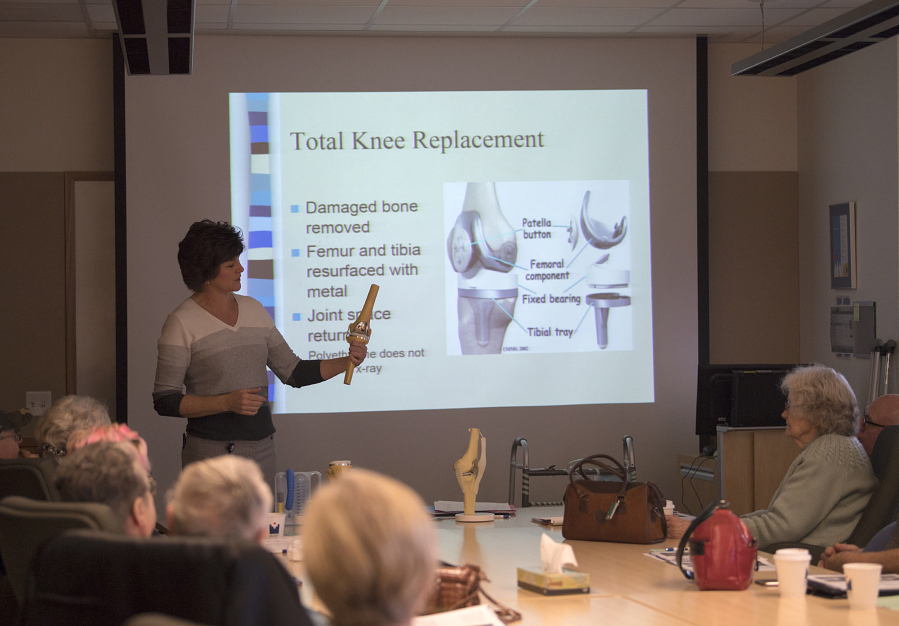Diane Buelt’s knees have been achy for as long as she can remember.
Twenty years ago, she gave up running due to the joint pain from cartilage rubbing together. She underwent a procedure designed to slow down the deterioration, but it couldn’t stop it from progressing.
For two decades, Buelt, 60, experienced pain that went from occasional to nagging to persistent.
About a year ago, the pain in her left knee became significant. She went to see Dr. Todd Borus, an orthopedic surgeon at Rebound Orthopedics and Neurosurgery, in September.
He gave the Fisher’s Landing woman news she didn’t want to hear: She needed not one, but two, knee replacement surgeries.
“I was in total denial,” Buelt said. “I felt like I was too young.”
Buelt postponed undergoing surgery until after she participated in Cycle Oregon — a several-hundred-mile bike ride through Oregon — and took a planned vacation to Europe.
She saw Borus again in late January. This time, he had a good news for Buelt. Legacy Salmon Creek Medical Center was now offering robotic-assisted total-knee replacements using MAKOplasty technology. The hospital began offering MAKOplasty partial-knee replacements in December 2009 — Buelt wasn’t eligible for procedure; the damage to her knees was too severe — and, three years later, added MAKOplasty total-hip replacements.
In January, Borus performed the first MAKO total-knee replacement at the Salmon Creek hospital. Buelt will undergo the procedure on April 5.
“I just feel very fortunate that the timing worked out,” Buelt said.
The MAKO technology uses CAT scans of the patient’s joint to create a 3-D image of the knee, giving surgeons a blueprint. The computer software uses sensors placed on the patient to register the body and machine using satellite technology.
“The real power of this technology … is that based on a pre-operative scan, you can create a virtual model of that patient’s knee,” Borus said.
That enables the surgeon to create a plan that will work best for the patient. The robotic arm guides the surgeon while making bone implants and positioning the implants, Borus said. While he controls the robotic arm, if he tries to move outside of the mapped area, the robot stops him.
The technology is also helpful in finding the soft-tissue balance of the knee. The ligaments and tendons surrounding the implant need to be at the right tension. If they’re too tight or too loose, the knee won’t be balanced and won’t be comfortable through the ranges of motion, Borus said.
“Before the operation starts, we’re able to get a really good assessment of the soft tissue of the knee and make adjustments,” he said. “That’s been the most powerful thing for me.”
Without the technology, knee replacement procedures would require surgeons to place the components and then try it out.
“A lot of times, it is sort of an eyeball test,” Borus said.
Sometimes, everything would be placed just as needed. Many times, however, surgeons aren’t happy with the placement — the knee is too tight or too loose in a certain position — and they have to recut the bone and tighten or loosen the tissues to find better balance, Borus said.
To date, Borus has performed more than 15 total knee replacements with MAKO technology. Post-operative X-rays have shown the soft tissue balance of the knees and the position of the implants have all gone “exactly according to plans,” he said.
“Universally, what I’m hearing from others doing MAKO total knee, the feeling has been the same,” Borus said. “You end up with a perfectly executed total knee replacement.”
That’s particularly valuable for patients who want to maintain their active lifestyles, Borus said. The fastest growing segment of the knee replacement population is the younger, active group — people in their 40s or 50s who sustained athletic injuries in their teens and 20s, he said.
“People who have remained active and, in doing so, have developed really significant arthritis at early ages,” Borus said. “For these patients, it’s paramount that you get the operation right the first time.”
Count Buelt as part of that group. She wants to get back to cycling and playing golf without pain.
“I’ve tried to not let these knees slow me down,” Buelt said. “But I’m looking forward this summer to being out there walking the golf course.”




